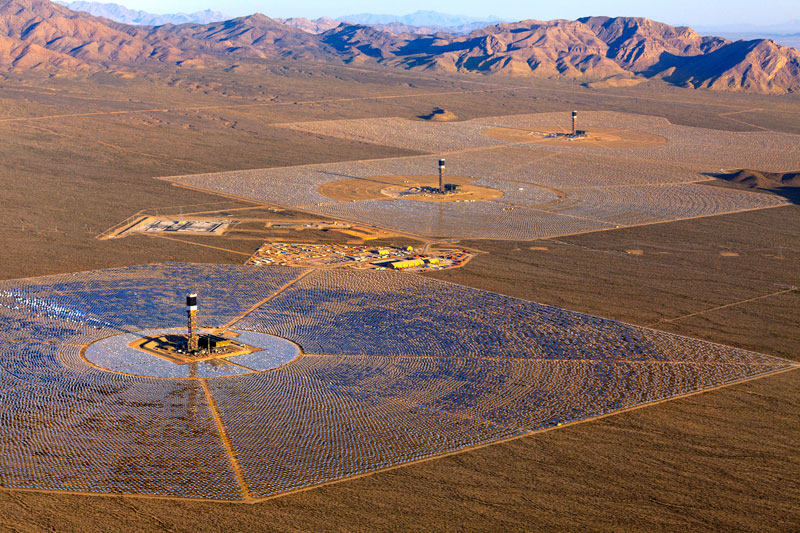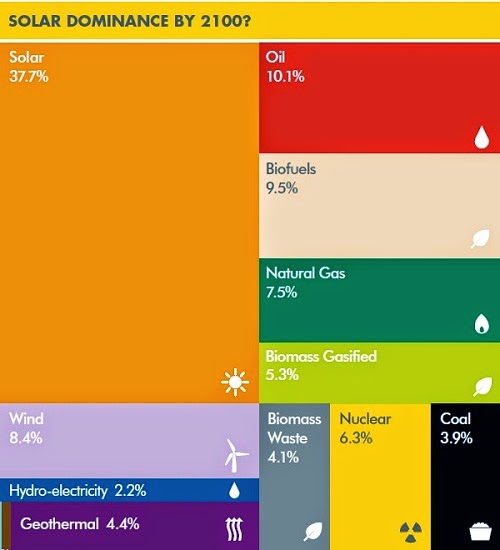Solar Energy Around the World
Posted by Nichollas Saucedo on June 20, 2014
 A renewable and clean source of energy, the solar power generated by the sun provides the earth with more than one thousand times the energy required by people around the world every day.
A renewable and clean source of energy, the solar power generated by the sun provides the earth with more than one thousand times the energy required by people around the world every day.
Using photovoltaic (PV) cells, sunlight is captured directly and transformed into electricity. The cells are semiconductor devices, usually made of silicon, which contain no liquids, corrosive chemicals or moving parts. The PV panels require little maintenance, do not pollute, and operate silently, making photovoltaic energy a very clean and safe method of power generation. [SOURCE]
According to a recent report by the European Photovoltaic Industry Association (EPIA), the global PV market has grown over the past decade at a remarkable rate - even during difficult economic times - and is on the way to becoming a major source of power generation for the world:
At the end of 2009, the world’s cumulative installed PV capacity was more than 23 GW. One year later it was 40.3 GW and at the end of 2011 it was 70.5 GW. In 2012, the 100 GW mark was reached and by 2013, almost 138.9 GW of PV had been installed globally – an amount capable of producing at least 160 terawatt hours (TWh) of electricity each year. This energy volume is sufficient to cover the annual power supply needs of over 45 million European households. This is also the equivalent of the electricity produced by 32 large coal power plants. The global cumulative installed capacity could have reached 140 GW in 2013 if the additional 1.1 GW in China were taken into account.
Geir Tjetland, manager of Skagen Vekst, a Norwegian and global equity fund, reports that in 2013 the public sector invested US$1.3 billion in solar energy around the world, driven by its biggest investors, China and Japan, and this kind of energy could surpass hydroelectric production.
The United States beat a record on solar energy installation in 2013 with the growth of 41% of its capacity. They installed 4751 MW of PV within one year – 2016 MW were installed in the fourth quarter alone – and over half of the new solar power plants were built in California, which is home to the largest solar power plant in the world. At the end of 2013, the US had more than 445,000 solar systems producing energy, this represented 12,000 MW of PV and 918 MW of concentrated solar power and the capacity to provide energy for 2.2 million homes.
 In September 2013, the Ivanpah Solar Power Facility was connected to California’s electricity grid in an initial sync testing and officially opened in February 2014. With close to 350 thousand mirrors, the Ivanpah Facility is the world’s largest solar power plant. It was funded by Google and cost US$2.2 billion. The mirrors are programmed to reflect sunlight to the top of a tower, which is a water reservoir. The sunlight heats the water until it becomes steam and powers the turbine. Ivanpah has a capacity of 392 MW, which is enough to supply 140 thousand homes around California and prevent 400 thousand tons of carbon dioxide emissions per year. However, according to the Wall Street Journal, the Ivanpah power plant has been criticized for its cost – some specialists claim Ivanpah’s US$2.2 billion price tag is approximately twice the cost of conventional sources of power generation – and its potential damage to the surrounding environment – some biologists say the Facility is causing deaths of birds in the area due to the heat generated near the towers, which can reach temperatures above 500 º C.
In September 2013, the Ivanpah Solar Power Facility was connected to California’s electricity grid in an initial sync testing and officially opened in February 2014. With close to 350 thousand mirrors, the Ivanpah Facility is the world’s largest solar power plant. It was funded by Google and cost US$2.2 billion. The mirrors are programmed to reflect sunlight to the top of a tower, which is a water reservoir. The sunlight heats the water until it becomes steam and powers the turbine. Ivanpah has a capacity of 392 MW, which is enough to supply 140 thousand homes around California and prevent 400 thousand tons of carbon dioxide emissions per year. However, according to the Wall Street Journal, the Ivanpah power plant has been criticized for its cost – some specialists claim Ivanpah’s US$2.2 billion price tag is approximately twice the cost of conventional sources of power generation – and its potential damage to the surrounding environment – some biologists say the Facility is causing deaths of birds in the area due to the heat generated near the towers, which can reach temperatures above 500 º C.
Reducing our dependence on fossil fuels and addressing environmental issues is a priority in the years ahead. The world’s energy consumption is 10 terawatts (TW) per year and by 2050, it is projected to be about 30 TW. The world will need about 20 TW of non-CO2 energy to stabilize CO2 in the atmosphere by mid-century.
More research and technological developments must occur to improve the efficiency of solar energy and cheapen its installation costs. Fortunately, the photovoltaic market is growing at the very high rate of 35–40% per year, which is similar to that of the telecommunication and computer sectors, and if the global PV capacity continues at its current rate, it could reach 300,000 MW by 2020.
Energy generation from photovoltaic technology is simple, available everywhere, unlimited, practically maintenance free, clean, and suitable for off-grid applications. We need to develop affordable solar energy technologies in order to replace conventional coal, gas, and nuclear-powered generating facilities. We need to unlock the considerable potential of solar energy to supply a high-quality and reliable electric power to the world.

Edited from original submission.
Filed under: Students on Sustainability